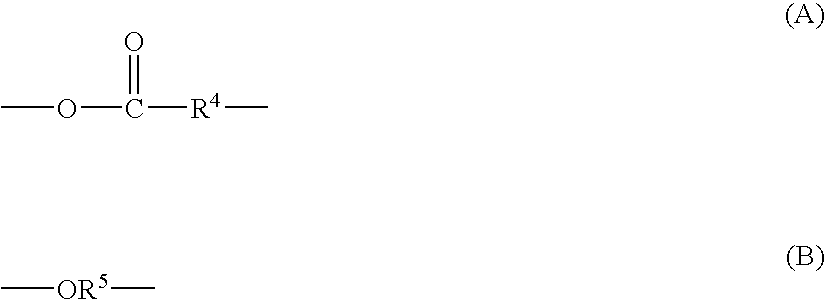Silyl group-containing polymer and its production process
a technology of silyl group and polymer, which is applied in the field of new silyl group-containing polymer and its production process, can solve the problems of insufficient weather resistance, reduced cure degree, and insufficient weather resistance, and achieves excellent antifouling properties and weather resistance, cure quickly and strongly, and favorable rubber elasticity
- Summary
- Abstract
- Description
- Claims
- Application Information
AI Technical Summary
Benefits of technology
Problems solved by technology
Method used
Image
Examples
example 1
(First Step)
[0184]To a 10 L pressure reactor made of stainless steel equipped with a stirrer, 500 g of polyoxypropylene diol (Mn=1,000) as an initiator and zinc hexacyanocobaltate having tert-butyl alcohol as the ligand (hereinafter sometimes referred to as TBA-DMC catalyst) in an amount of 50 ppm based on the finish mass were charged.
[0185]The reactor was replaced with nitrogen, the temperature in the reactor was raised to 140° C., and 50 g of PO was charged in the reactor and reacted (DMC catalyst activating step by pre-supply of PO: step of activating the DMC catalyst by preliminarily supplying a small amount of PO). Then, after the pressure in the reactor decreased, 2,250 g of PO (the total addition amount of PO was 2,300 g) and 1,200 g of CL were charged at constant rates to the reactor to prepare a first mixed liquid. After PO and CL were charged over a certain period, the first mixed liquid was stirred for one hour for reaction while keeping the temperature of the first mixed...
example 2
(First Step)
[0188]A polyester ether polyol (polyol B) was obtained in accordance with step 1 in Example 1 except that the amount of PO added afterward was 2,500 g (the total addition amount of PO was 2,550 g) and that the addition amount of CL was 1,950 g. From results of measurement by 13C-NMR, the polyol B was confirmed to have a random copolymer chain of CL and PO.
(Second Step)
[0189]A silyl group-containing polymer B was obtained in accordance with step 2 in Example 1 except that the polyol B was used instead of the polyol A and that the addition amount of TMS was 127.4 g.
example 3
(First Step)
[0190]Using the same reactor as in Example 1, polyoxypropylene triol (Mn=1,000) as an initiator and a TBA-DMC catalyst in an amount of 50 ppm based on the finish mass of polyol C were charged. PO was reacted through the DMC catalyst activating step by pre-supply of PO, to obtain 5,000 g of polyoxypropylene triol having Mn of 10,000. A polyester ether polyol (polyol C) was obtained in accordance with step 1 in Example 1 except that 5,000 g of the above polyoxypropylene triol was used as an initiator instead of the initiator used in Example 1 and that 2,000 g of PO and 1,000 g of CL were added. From results of measurement by 13C-NMR, the polyol C was confirmed to have a random copolymer chain of CL and PO.
(Second Step)
[0191]A silyl group-containing polymer C was obtained in accordance with step 2 in Example 1 except that the polyol C was used instead of the polyol A and that the addition amount of TMS was 84.2 g.
PUM
| Property | Measurement | Unit |
|---|---|---|
| molecular weight distribution | aaaaa | aaaaa |
| molecular weight distribution | aaaaa | aaaaa |
| molecular weight distribution | aaaaa | aaaaa |
Abstract
Description
Claims
Application Information
 Login to View More
Login to View More - R&D
- Intellectual Property
- Life Sciences
- Materials
- Tech Scout
- Unparalleled Data Quality
- Higher Quality Content
- 60% Fewer Hallucinations
Browse by: Latest US Patents, China's latest patents, Technical Efficacy Thesaurus, Application Domain, Technology Topic, Popular Technical Reports.
© 2025 PatSnap. All rights reserved.Legal|Privacy policy|Modern Slavery Act Transparency Statement|Sitemap|About US| Contact US: help@patsnap.com



